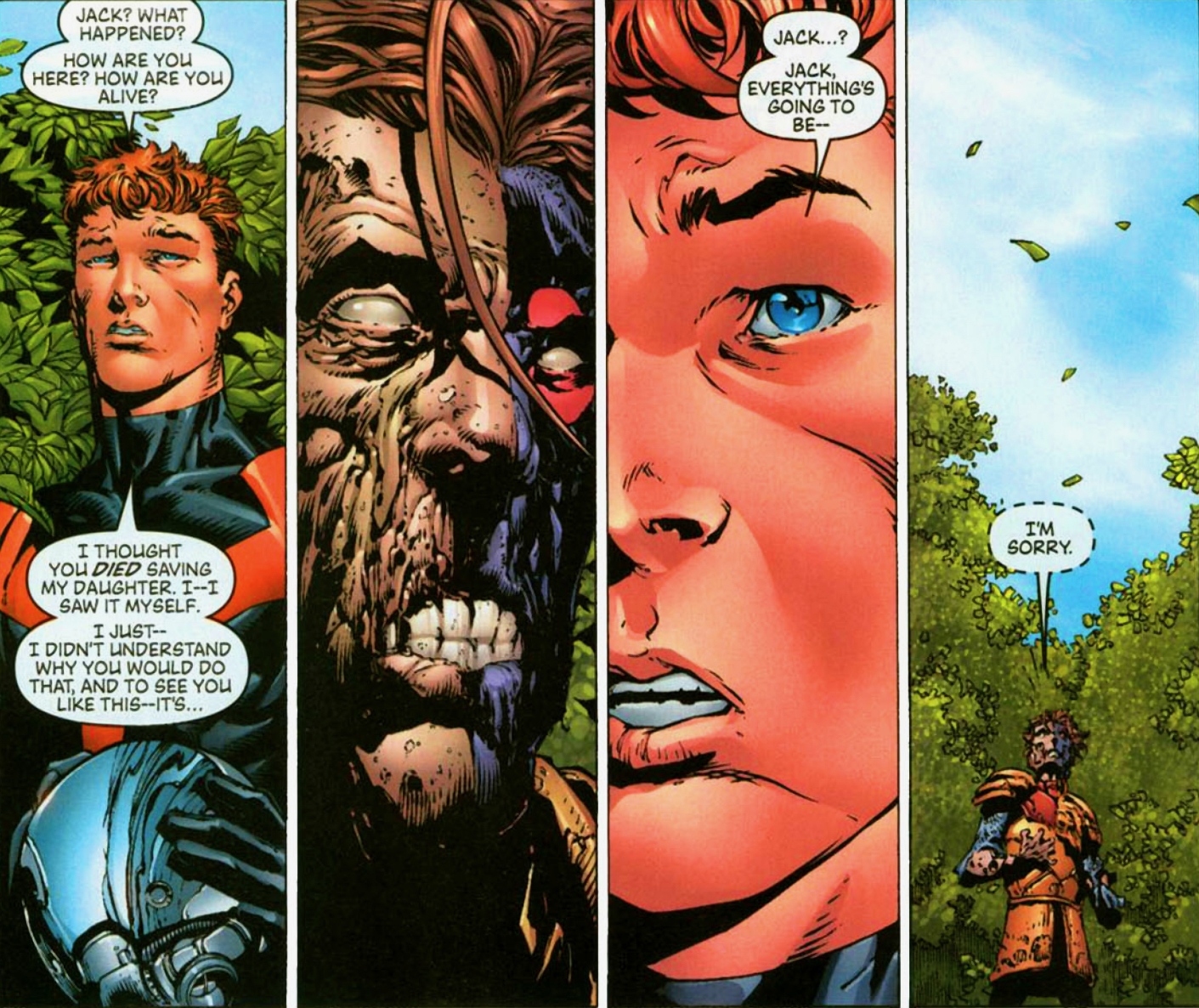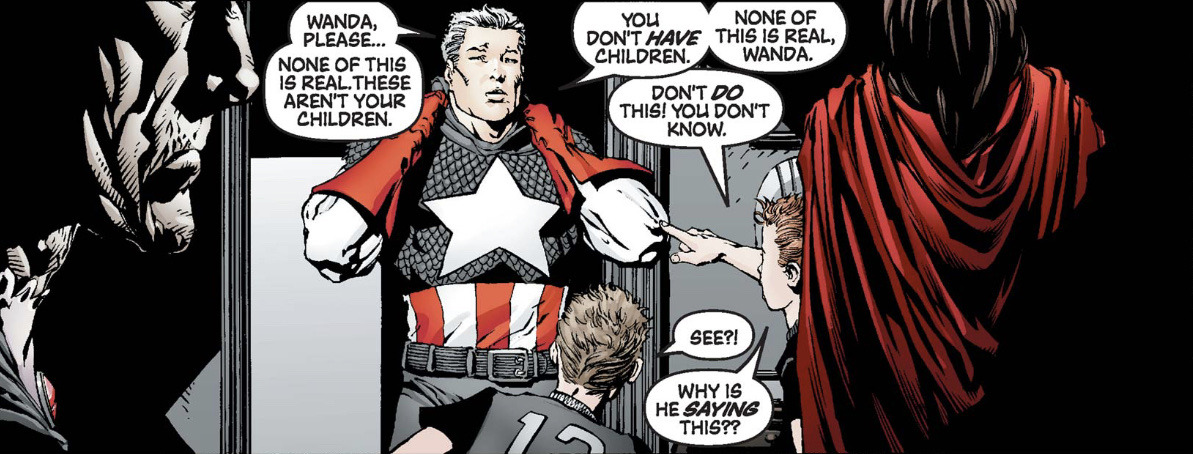
Here we are, at the event was very controversial when it happened but, in retrospect, wasn’t close to the most controversial event of the mid-2000s (that would be House of M) and wasn’t even close to the most controversial thing Brian Michael Bendis ever did at Marvel (there are many of these, including the afore-mentioned House of M, Secret Invasion, and breaking the promise against ever merging the 616 and Ultimate universes).
Full disclosure, I liked all those things and I really enjoyed Avengers: Disassembled.
It starts with zombie Jack of Hearts blowing up Avengers Mansion, killing Scott Lang by burying him in rubble.

Yes, that’s how it starts.
(Note: Scott’s not really dead. Many months later, he is revealed to have survived the cave-in.)
Meanwhile, the core characters’ lives begin to become chaotic. (“Chaos” is the in-story name for these issues.) Captain America, who recently slept with Scarlet Witch, breaks up with her. Tony Stark appears to be drunk but hasn’t taken a drink, gets into a fight with the Latverian ambassador (for reasons explained in the Iron Man tie-in–which you can find by clicking the “disassembled” link at the bottom of this post), leading to the revocation of the Avengers’ status. Meanwhile, Thor is dead. Vision crash-lands into the wreckage of Avengers mansion and then pukes up little Ultrons. In response, She-Hulk kills him.

Wasp is injured during She-Hulk’s hulking out, and Hank takes her to the hospital—which gives him a chance to make amends to his ex-wife for having abused her in the past, and the two reconcile.
All the past Avengers show up to support the team.
Adding character tags for this story is taking hours!
But then a third Avenger is killed—Hawkeye “suicide bombs” with his own arrows during a fight with the Kree (whose invasion is also shown in the pages of Fantastic Four which, again, you can find by clicking that “dissembled” tag below)).
At last, Doctor Strange arrives and tells them that this parade of horrible events is being caused by magic. Wanda’s magic. She’s gone nuts after remembering her children—who never really existed anyway. Her children were created by Wanda’s own desire and Mephisto’s evil magic, and had to be destroyed when they began to push Wanda out of control. Note that Wanda had forgotten about them due a spell by Agatha Harkness, who she kills during this story after seeking to clarify what happened to the twins.


Fury finds the body.

Wanda’s chaos magic is warping reality and, according to Doctor Strange, she must be stopped before it all gets even worse. Before this big reveal, we saw silhouettes of the twins—talking about how they wanted to make the Avengers suffer for killing them. It’s all very well done, in my view: Scarlet Witch’s subconscious is re-manifesting the twins again, and they are avenging their own deaths against the heroes who helped “kill” them.
She recreates them.

And then Captain America arrives to tell her it’s not real.

Before we get to the final act, I think it’s probably worth noting that the reason Wanda finds out about having created her own children is because Wasp gets drunk and lets it slip—which helps form the basis for Wanda’s feelings of betrayal that serve as catalysts for this whole event.


So, while Wasp was kind of responsible for forming The Avengers (she named the group, back in issue #1), she’s now partially responsible for disassembling the team as well.



In the big confrontation, Wanda conjures version of a bunch of big time enemies: Rogue, Ultron, Red Skull, Nazis, etc. Big fight, but Strange is able to knock Wanda out and put her in stasis.
Lying in a coma, Magneto claims her unconscious body hoping that Professor X can help heal her psyche.



In the “Finale” one-shot, the team returns to the ruins of their mansion for a final dinner.

They pay tribute to the fallen.

The mansion is turned into an historical landmark.

There is a candlelight vigil of gratitude.

And the team members all go their separate ways.

Note: The “finale” issue has a dozen artists, each doing a few pages and paying tribute to major events in Avengers history. It’s a solid comic, but not essential.
“Disassembled” not only ended one of the oldest Marvel titles, but it also marked a beginning of a very new, very different 616-Universe architecture. We’d seen signs of it before, in books like Daredevil and Punisher, but now, clearly, the “Lee/Kirby” traditions were no longer sacred and any vestiges of the Jim Shooter editorial style—or the hyper-stylized ‘90s movement—were removed. Going forth, many titles would matter to each other and continuity would become increasingly interdependent. It was the birth of a new kind of Marvel, and one that did well for the publisher for well into the next decade.
Specifically, this event is a direct precursor to House of M, which would do to the mutant-side of Marvel what this story did to the Avengers, and also Young Avengers, where Wanda’s children would return in more stable, prominent roles.



